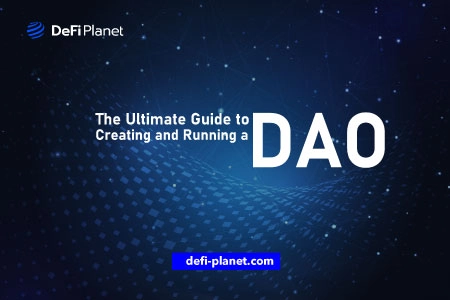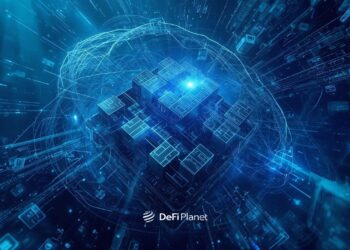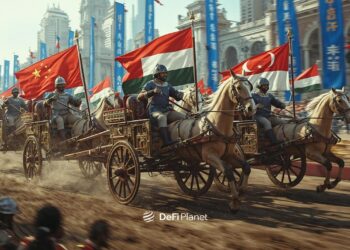Distributed Autonomous Organizations (DAOs) are being promoted as the next technological revolution in industries such as banking and finance. Members of these blockchain-powered, member-only communities use distributed ledger technology to achieve their objectives.
DAOs have many advantages over traditional organizations because they use decentralization, community-driven decision-making, and democratic voting to advance the goals that are important to their members. Smart contracts are essential for any crypto project, such as a DAO, to function correctly.
Getting started with DAO creation on the blockchain may seem daunting at first, but this guide will walk you through the simple steps to creating and running a DAO.
What is a DAO?
A Decentralized Autonomous Organization (DAO) is a group that operates on the blockchain in accordance with pre-established rules. One notable feature is the absence of a clear chain of command within the organization. In other words, no one has complete independence, even if some members have more say than others.
DAOs typically bring together a group of people who are all working towards the same goal, examples of which include charity initiatives, DeFi activities such as investment DAOs, or pooling resources to acquire NFTs, as in a Collector DAO). A DAO can be joined by anyone who has the DAO’s tokens.
Requirements of a DAO
Although intriguing, a DAO doesn’t require much to function. The requirements of a DAO include the following:
- Purpose: This refers to the benefits members will gain from a DAO beyond the novelty factor.
- Voting Procedure: This shows how members will vote.
- Treasury: A secure treasury is essential if the goal of a DAO is to generate profits for its investors. More people will join if there is a larger pool of money available.
- Members: It’s important to keep in mind that a successful DAO must have a robust community and offer incentives to its members.
Things to Note Before Creating a DAO
The liability of DAO participants may be unlimited.
DAOs and corporations are different. They don’t bother with the paperwork required of a legitimate business. There may be other costs involved besides financial loss.
DAOs face numerous legal obstacles.
Due to their decentralized nature, DAOs are not recognized as legal entities, particularly in the United States. They do not receive special treatment from the government or the benefits of corporate status. In other words, resolving legal issues within a DAO is difficult.
Members of the DAO can remain anonymous.
Members of a decentralized autonomous organization can maintain their anonymity due to the group’s structure. Members can only view the wallet addresses of their co-members.
How to Create and Run a DAO
Step 1: Determine the structure of the DAO project
To create a DAO from scratch, it is crucial to first figure out its basic structure.
It is important to remember that the advantages of a decentralized system are not universally applicable.
The following are some considerations for determining the structure of a DAO project:
- Goals and purpose of the DAO
- Decisions that the DAO will make
- Willingness to embrace a decentralized, community-oriented ownership structure
- Difficulty in the industry that necessitates creating a DAO
- Relevance of the DAO to a community, its members, and customers
- Possibility of launching a business without the DAO
- Technical and developer resources required for establishing the DAO
- Readiness to face the unpredictable nature of the cryptocurrency market
Step 2: Determine the DAO type
The next step after deciding on a DAO structure is determining the DAO type. Since DAOs are still a developing concept, it would be premature to list all of the possible applications. However, there are some legitimate fields in which DAOs can have a transformative impact.
While a DAO does not have to be run within a traditional nation-state or city-state governance structure, such a framework is a good place to start when sketching out the larger DAO framework.
It is not always clear what type of DAO is required. As a result, the following DAO types will assist in narrowing one’s options:
Protocol DAOs
A protocol DAO is the most common type of DAO, as it operates independently of any central authority.
As the name implies, a protocol DAO is concerned with decentralized governance protocols. Several DAOs use smart contract technologies to provide DeFi services. Uniswap, MakerDAO, and Yearn Finance are three of the most popular protocol DAOs.
Investment DAOs
DAOs are commonly used in business fundraising, specifically through investment DAOs.
Startups that intend to fund their operations with blockchain technology and digital currencies often use investment DAOs (also known as venture DAOs)
Grant DAOs
Investment DAOs and Grant DAOs both aim to support novel endeavours, but Grant DAOs focus exclusively on DeFi initiatives. The Uniswap Award is one of the most coveted DAO grants.
Social DAOs
Social DAOs are networking hubs for the cryptocurrency industry. They facilitate communication and interaction among users. Digital democracy is strengthened in places like these forums by giving everyone a chance to speak and encouraging people to talk about topics that are important to them.
Collector DAOs
Non-fungible token (NFT) artists use collector DAOs to prove ownership of their creations. PleasrDAO is one of these projects. It is a DAO that is made up of NFT collectors, DeFi promoters, and digital creators.
Media DAOs
Media DAOs reward content creators (in this case, the readers) with native currency in exchange for their contributions while eliminating the need for intermediaries such as advertisers. For instance, Forefront is a place where crypto enthusiasts can learn the ropes and where businesses in incubators can grow.
Entertainment DAOs
Entertainment DAOs offer decentralized entertainment by empowering individuals to bring their ideas to life while retaining governance over their projects. Members of the popular entertainment group DAO Flufworld can create and license their own unique 3D NFT Fluffs.
Philanthropy DAOs
These DAOs are set up to help social responsibility projects in the Web3 space succeed. The Big Green DAO is the first DAO to donate money to charitable causes and educate people about sustainable agriculture.
Step 3: Decide on the DAO token’s supply, distribution, and rewards
The DAO creator must be familiar with the concept of token allocation. If not, then more research needs to be done. Once the creator completely understands the DAO token’s structure and type, token allocation can begin. Getting this part right from the start will make it much easier to raise funds and gain support from one’s core audience.
The DAO development team must make the correct decision regarding the total number of tokens and how they will be distributed. To maximize profits, it is critical to understand how the DAO token will be used and distributed.
Investors in a DAO will want to see a return on their initial investment, just like investors in any other type of venture. That’s why it’s crucial to always have enough money on hand to cover operating expenses while also giving back to the community.
Step 4: Create the DAO
Although startups can build their systems from the ground up, they can also use DAO startup templates and tools. The templates and tools can assist with:
- Determining the DAO’s underlying legal framework.
- Minting DAO coins
- Setting up teams
- Recruiting members, and
- Naming the DAO
The most popular Ethereum blockchain applications for creating a DAO include:
- Aragon
- Syndicate
- Colony
- OpenLaw
- Orca Protocol
- DAOstack
Step 5: Create the DAO treasury
After issuing and distributing the DAO tokens for the initial coin offering, it is necessary to have a plan in place to safely store the funds. Some of the top DAO treasury tools include:
- Gnosis Safe
- Juicebox
- Multis
- Llama
- Utopia
- Parcel
Step 6: Build a community
Any DAO relies on a dependable, decentralized group of people. It’s critical to emphasize community building when creating a DAO. An active, supportive, and engaged community can help the DAO project grow exponentially.
The openness with which the community is invited to participate in management and decision-making is critical to the success of any DAO project.
In Conclusion,
- Web3 innovations like DAOs make it possible for new businesses, artists, and online communities to do almost anything.
- The process of creating a DAO is straightforward. Nonetheless, there are numerous challenges to overcome when running a DAO.
- The decentralized nature of DAOs raises questions about their legitimacy, especially in the United States. This could make resolving legal disputes within the organization difficult. To keep a DAO running smoothly, there must be a dedicated community and a compelling reason for its existence.
- Before creating a DAO, it is crucial to learn about the different DAO tools, and the community should be the top priority.
- A DAO has a high chance of success if it is built with the right tools, tokenomics, and people.
If you would like to read more articles like this, visit DeFi Planet and follow us on Twitter, LinkedIn, Facebook, and Instagram.
“Take control of your crypto portfolio with MARKETS PRO, DeFi Planet’s suite of analytics tools.”





















